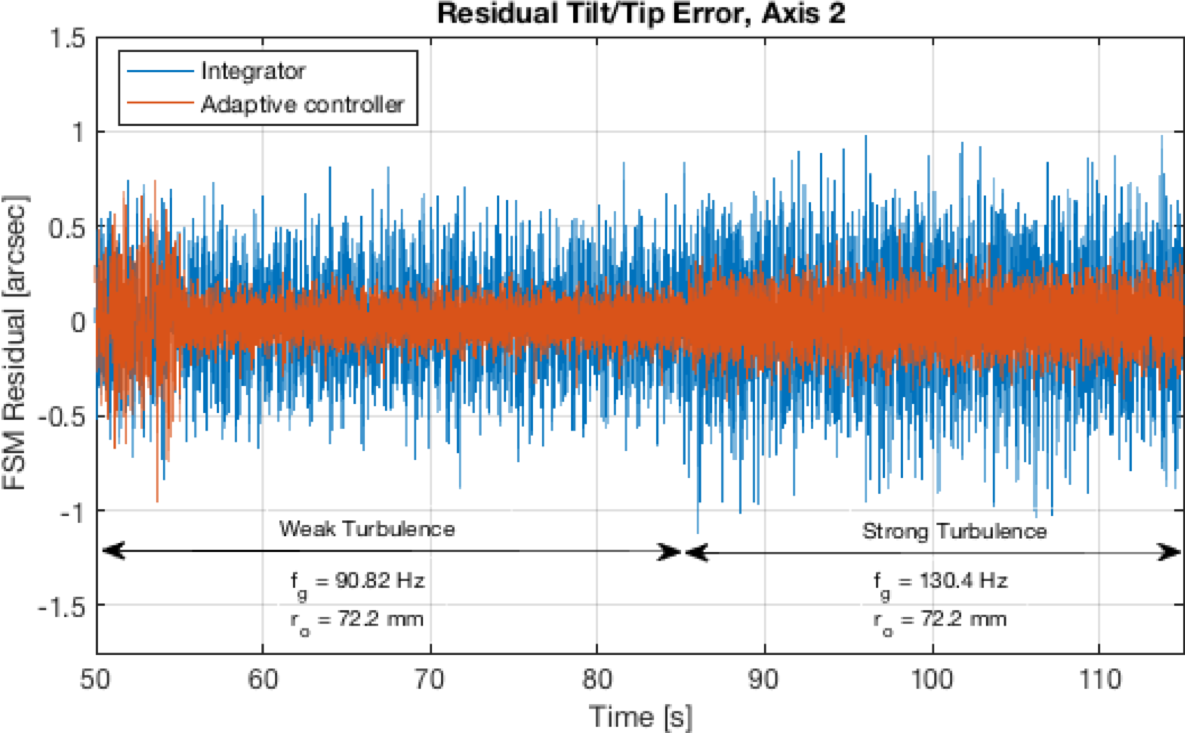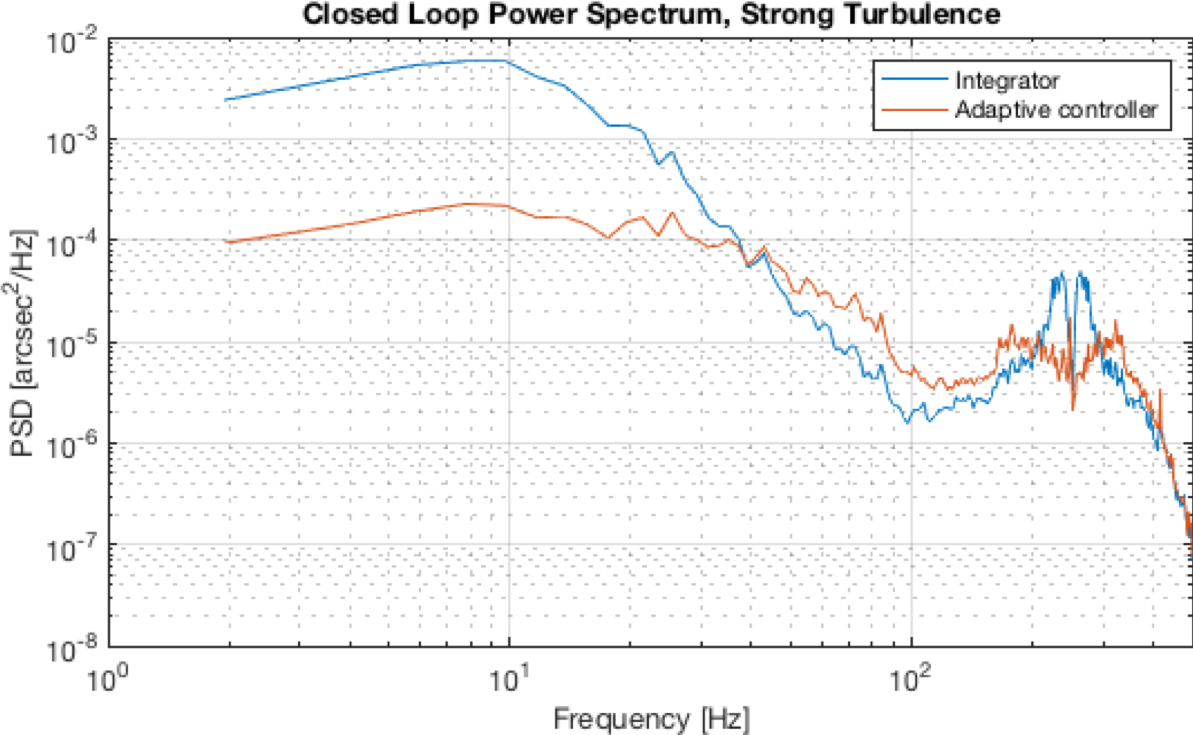Adaptive Predictive Control
Project Objectives
Next generation laser communications systems will use medium to large-aperture telescopes as ground terminals. In order to achieve high data rates using modulation methods such as DPSK, each telescope in the network will be equipped with an adaptive optics (AO) instrument to remove atmospheric turbulence and enable injection of the downlink laser into a single-mode fiber. These future AO systems must deliver diffraction limited performance, and provide high levels of disturbance rejection similar to those required for current astronomical AO. Achieving this level of correction, especially at sites with sub-optimal atmospheric seeing, necessitates advanced predictive control laws that mitigate computational latency by predicting wavefront turbulence. Unlike astronomical AO, however, laser communications terminals will require nearly continuous day and night operation, with constantly evolving atmospheric statistics, target illumination, and telescope disturbances, rendering the identification of a time-invariant optimal controller impractical.
This project aims to demonstrate a new type of adaptive controller that has been under development at UCLA, which produces an optimal control command that minimizes wavefront error over a finite future horizon. Unlike time invariant optimal controllers, the UCLA approach employs a novel Recursive Least Square (RLS) lattice filter that continually tailors the controller's parameters to match the prevailing disturbance power spectra. The lattice filter is computationally efficient and fully multichannel, allowing many spatial modes to be jointly optimized with a minimal impact on latency, a requirement for application to AO instruments. Our objective was to implement a fully adaptive, multichannel predictive control system on a facility-class AO instrument, and demonstrate improved disturbance rejection versus the standard integrator-based controller.
Approach and Results
This project used the Integrated Optical System (IOS), an "extreme" AO system under development at JPL for the Laser Communications Relay Demonstration. IOS is a woofer-tweeter AO instrument, possessing a fast steering mirror (FSM), and high and low-order deformable mirrors. Given the uncertain computational load of the adaptive control algorithm, we chose to limit the adaptive controller to the two tilt/tip channels feeding the FSM, treating them as coupled channels. Further, while the IOS real-time control software (RTC) can operate up to a 20 kHz from rate, we restricted testing to 1 kHz. Future implementations can easily scale to additional deformable mirror channels and higher rates.
Since the theoretical aspects of the adaptive controller are well understood, much of this task was devoted to software development and hardware-in-the-loop testing. The result was the architecture depicted in Fig. 1, where additions to the IOS real-time controller (RTC) are shown in blue. The modifications included several multichannel transfer functions, which were implemented using a novel state-space approach. The control objective in Fig. 1 is to minimize the residual tilt/tip error, which is picked off by the adaptive controller as an input. An internal model of the instrument dynamics is used to provide an estimate of the external atmospheric turbulence. Then, the RLS lattice filter predicts a particular linear combination of future disturbances. It does so by training on past data, finding the optimal linear combination of wavefronts that minimize the prediction error, and applying that combination to the current measurement. This prediction is fed into a LQR state regulator to generate the optimal control command, which is then sent to the IOS integrator.

Hardware experiments began by identifying accurate multichannel models of the plant dynamics using a modified version of the Ho-Kalman realization algorithm. Then, we tested the adaptive controller using the IOS Atmospheric Turbulence Simulator (ATS), which produces realistic wavefront aberrations over a wide range of seeing conditions. Figure 2 compares the performance of the standard integrator (gain=0.1) and adaptive controllers under two turbulence scenarios. First, a weak disturbance was applied using a 5 m/s wind speed. Here the adaptive controller significantly outperforms the integrator, achieving a mean rms error of 0.06 arcsec compared to 0.23 arcsec for the integrator. The wind speed is increased at 85 seconds to 13 m/s. The adaptive controller autonomously tracks the turbulence statistics and achieves a mean rms error of 0.09 arcsec, compared to 0.29 arcsec for the integrator. Frequency-domain results, shown in Fig. 3, are more revealing. In both turbulence regimes the adaptive controller clearly reduces the residual error over a wider range of frequencies. While the integrator disturbance rejection bandwidth is theoretically limited to approximately 10 Hz, the adaptive controller provides significant mitigation of the high frequency peaks around 250 Hz.




Significance of Results
This demonstration illustrates the viability of adaptive controllers for adaptive optics, and presents a practical real-time control implementation. Experimental data using realistic wavefront turbulence show that the adaptive controller is capable of significantly improved disturbance rejection bandwidth. This level of performance is autonomously maintained when the disturbance statistics change significantly, without the need to explicitly re-identify a disturbance model. As future AO systems push for higher wavefront correction, employing similar adaptive controllers could provide significant performance margin, enabling lower cost hardware and adding robustness under non-ideal operating conditions.
Publications
Adaptive control for the IOS adaptive optics system
Jonathan Tesch, Tuan Truong, Lewis C. Roberts Jr. & Steve Gibson
Proc. SPIE, vol. 11135, 1113509 (2019)
Copyright 2019 Society of Photo Optical Instrumentation Engineers. https://doi.org/10.1117/12.2527386
